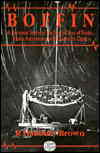The Battle of the Atlantic and Signals Intelligence
U-boat Situations and Trends, 1941-1945
Syrett, David
1999, Published by Ashgate for the Navy Records Society, Brookfield VT
ISBN 1840142952
628 pages
| Type. | Compilation of British Intelligence documents |
| Pros. | Fascinating primary source |
| Cons. | Editor's notes are not always correct |
| Rating. |  |
 This massive book is an edited compilation of British intelligence documents. The Situations are weekly reports, which were produced from 15 December, 1941 to May, 1945. Each of these reports begins with a table showing the number of U-boats thought to be present in each operational area (e.g., the Arctic, various sectors of the North Atlantic, Central Atlantic, Mediterranean, etc.) at quite a detailed level and often comprising several dozen sea and coastal areas. The table is followed by an up-to-the-minute summary of the activities of both U-boats and Allied ASW forces, providing a snapshot of current engagements as well as an overview of events of the past week. The Trends were initiated in an attempt to summarize technological developments and trends in strategy and tactics, and appeared from 2 November, 1942 irregularly until 21 May, 1945. Not all of the Trends were preserved for posterity, and thus many do not appear in this book.
This massive book is an edited compilation of British intelligence documents. The Situations are weekly reports, which were produced from 15 December, 1941 to May, 1945. Each of these reports begins with a table showing the number of U-boats thought to be present in each operational area (e.g., the Arctic, various sectors of the North Atlantic, Central Atlantic, Mediterranean, etc.) at quite a detailed level and often comprising several dozen sea and coastal areas. The table is followed by an up-to-the-minute summary of the activities of both U-boats and Allied ASW forces, providing a snapshot of current engagements as well as an overview of events of the past week. The Trends were initiated in an attempt to summarize technological developments and trends in strategy and tactics, and appeared from 2 November, 1942 irregularly until 21 May, 1945. Not all of the Trends were preserved for posterity, and thus many do not appear in this book.
Obviously this book is a useful resource for those who wish to learn just what the British knew, and when they knew it. However, it was pleasantly surprising to find that this book is also good, often fascinating, reading. Steeling myself for a dry and cryptic summary of intercepted transmissions, and planning merely to look up a few key dates and names, I found instead a series of well-written narratives, and in the end read this book from cover to cover. Its interest lies not only in the chilling revelation of how comprehensively the British were able to follow the movements of individual U-boats, but also in the writers' clear, interesting, and often entertaining style. The excerpts below provide examples of the various types of information - relating to special operations, sabotage, and morale, in addition to location - gathered about the U-boats; and in some cases the personal observations, opinions, and even smug remarks on the part of the authors which appear periodically throughout the book.
-
U-boat Situation: Week ending 5 January, 1942 (Page 3). "The U-boat situation has one feature of particular interest: since 24/12 until 3/1 a U-boat has been employed solely to create a fictitious impression in our minds by moving rapidly through the Northwestern Approaches and making signals at short intervals on varied frequencies so as to simulate the presence of a considerable number of U-boats in the area. This U-boat has travelled from Faeroes to 50ºN 20ºW thence to 53ºN 25ºW thence to 56ºN
35ºW thence to 58ºN 25ºW thence to Biscay. […] The object of this ruse is thought to be the concealment of one or all of 3 actual moves which are now developing…"
U-boat Situation: Week ending 10 August, 1942 (Page 69): "Ten north Norwegian U-boats have been energetically chasing a mythical PQ convoy since one of their number reported, on 5th August, that he had sighted the escort and two columns of the convoy on a north-easterly course, 100 miles SE of Scoresby Sound. Extensive air reconnaissance was laid on but was hampered by bad weather and the error therefore remained unrevealed, with the result that nine of the U-boats are now disposed between South Cape, Spitzbergen and Bear Island, while the tenth is proceeding to the Eastern exit of the Hinlopen Straits […] in case the convoy should endeavour to pass north of Spitzbergen."
U-boat Situation: Week ending 8 February, 1943 (Page 134): "An increase has been noticeable of late in the incidence of incapacitating defects developing during outward passage of the Bay of Biscay."
U-boat Situation: Week ending 26 April, 1943 (Page 171): "…the spirit of the crews which are at present out on operations in the North Atlantic is low and general morale is shaky. There is little doubt that BdU shares this impression…"
U-boat Situation: Week ending 8 November, 1943 (Page 268): "The general enemy condition at the moment is one of ill coordinated and sullen response to nervously abrupt changes of policy and diversions of effort. Bewildered and crestfallen, the commanders shy away from their own imaginings of danger and count mythical victims to lull to sleep their own terror."
U-boat Situation: Week ending 31 January, 1944 (Page 312): "U-boat claims have been magniloquent and it seems that the younger the commander is the greater the success with which he credits himself."
U-boat Situation: Week ending 12 June, 1944 (Page 394): "Liaison between Captain U-boats Western Europe and Admiral Commanding U-boats has been bad in the main no doubt because of delay in communications. A single example will suffice: On D plus 5 Admiral U-boats thought no U-boats were at sea in Bay of Biscay until reminded by Captain U-boats West that 19 had been disposed in this area on D plus one."
U-boat Situation: Week ending 3 July, 1944 (Page 409): "The U-boat situation in the Channel is obscure and the obscurity is worrying Doenitz who on 2nd July somewhat plaintively informed the boats thought to be in the Spout that owing to the lack of reports from them it was impossible to estimate the situation and that they should therefore take every opportunity to report their experience. Without waiting for any such reports he has ordered 3 boats which were moving up Channel to break off and enter Brest…"
The editor has performed the valuable service of inserting notes identifying the U-boats as well as the submarines and warships of all nations (although not merchant ships) discussed in the text. The index references these notes as well as the main documents. However, although the author includes a selected bibliography, it is not clear where he has obtained the data he includes in the notes. Some of his notes identifying U-boat fates and successes do not match the data we have amassed on uboat.net. In some cases these discrepancies might be chalked up to typographical error, since at least one such case was noted (U-486 is mistyped as U-864 in the note and thus in the index). Others clearly result from reliance on old data, but nothing listed in the bibliography is a plausible source.
Even so, the main value of the book is as a historical document, revealing the amazing knowledge the British had - from their observation of the buildup to Operation Drumbeat, through their pinpointing of the supply U-boats, the recognition of the turn in the tide in May 1943 and the resumption of attacks months later which they seemed to regard as an anticipated event, to their detailed knowledge of the new U-boat types and technologies. Even though anyone familiar with the U-boat war knows that British Intelligence often literally knew more about the dispositions of individual U-boats than the Germans themselves did, reading the hundreds of pages of these documents adds a whole new dimension to that understanding.
Review written by Tonya Allen.
Published on 8 Jul 2000.
This title is highly recommended.
Return to our main review page.



